15 | Congratulations you just started a new Twilio 16 | Serverless project. 17 |
18 | 19 |Assets
20 |21 | Assets are static files, like HTML, CSS, JavaScript, images or audio 22 | files. 23 |
24 | 25 |26 | This HTML page is an example of a public asset, you can 27 | access this by loading it in the browser. The HTML also refers to 28 | another public asset for CSS styles. 29 |
30 |
31 | You can also have private assets, there is an example
32 | private asset called message.private.js in the
33 | /assets directory. This file cannot be loaded in the
34 | browser, but you can load it as part of a function by finding its path
35 | using Runtime.getAssets() and then requiring the file.
36 | There is an example of this in
37 | /functions/private-message.js.
38 |
Functions
41 |42 | Functions are JavaScript files that will respond to incoming HTTP 43 | requests. There are public and 44 | protected functions. 45 |
46 | 47 |
48 | Public functions respond to all HTTP requests. There is
49 | an example of a public function in
50 | /functions/hello-world.js.
51 |
54 | Protected functions will only respond to HTTP requests
55 | with a valid Twilio signature in the header. You can read more about
56 | validating requests from Twilio in the documentation. There is an example of a protected function in
59 | /functions/sms/reply.protected.js
60 |
twilio-run
63 | 64 |
65 | Functions and assets are served, deployed and debugged using
66 | twilio-run. You can serve the project locally with the command
69 | npm start which is really running
70 | twilio-run --env under the hood. If you want to see what
71 | else you can do with twilio-run enter
72 | npx twilio-run --help on the command line or check out
73 | the project documentation on GitHub.
76 |
 12 |
13 | ### Deleting a Push Credential
14 |
15 | We **do not recommend that you delete a Push Credential** unless the application that it was created for is no longer being used.
16 |
17 | When a Push Credential is deleted **any associated registrations made with this Push Credential will be deleted**. Future attempts to reach an `identity` that was registered using the Push Credential SID of this deleted push credential will fail.
18 |
19 | If you are certain you want to delete a Push Credential you can click on `Delete this Credential` on the [console](https://www.twilio.com/console/voice/sdks/credentials) page of the selected Push Credential.
20 |
21 | Please ensure that after deleting the Push Credential you remove or replace the Push Credential SID when generating new access tokens.
--------------------------------------------------------------------------------
/Docs/migration-guide-2.x-3.x.md:
--------------------------------------------------------------------------------
1 | ## 2.x to 3.x Migration Guide
2 |
3 | This section describes API or behavioral changes when upgrading from Voice Android 2.x to Voice Android 3.x. Each section provides code snippets to assist in transitioning to the new API.
4 |
5 | 1. [Making a Call](#migration1)
6 | 2. [Call State](#migration2)
7 | 3. [CallInvite Changes](#migration3)
8 | 4. [Specifying a Media Region](#migration4)
9 | 5. [ConnectOptions & AcceptOptions](#migration5)
10 | 6. [Media Establishment & Connectivity](#migration6)
11 | 7. [ProGuard Configuration](#migration7)
12 |
13 | #### Making a Call
14 |
15 | In Voice 3.x, the API to make a call has changed from `Voice.call(...)` to `Voice.connect(...)`.
16 |
17 | ```Java
18 | Call call = Voice.connect(context, accessToken, listener);
19 | ```
20 |
21 | #### Call State
22 |
23 | The call state `CallState` has moved to the Call class. It can be referenced as follows:
24 |
25 | ```Java
26 | Call.State
27 | ```
28 |
29 | #### CallInvite Changes
30 |
31 | In Voice Android 3.x, the `MessageListener` no longer raises errors if an invalid message is provided, instead a `boolean` value is returned when `boolean Voice.handleMessage(context, data, listener)` is called. The `boolean` value returns `true` when the provided data resulted in a `CallInvite` or `CancelledCallInvite` raised by the `MessageListener`. If `boolean Voice.handleMessage(context, data, listener)` returns `false` it means the data provided was not a Twilio Voice push message.
32 |
33 | The `MessageListener` now raises callbacks for a `CallInvite` or `CancelledCallInvite` as follows:
34 |
35 | ```Java
36 | boolean valid = handleMessage(context, data, new MessageListener() {
37 | @Override
38 | void onCallInvite(CallInvite callInvite) {
39 | // Show notification to answer or reject call
40 | }
41 |
42 | @Override
43 | void onCancelledCallInvite(CancelledCallInvite callInvite) {
44 | // Hide notification
45 | }
46 | });
47 | ```
48 |
49 | The `CallInvite` has an `accept()` and `reject()` method. The `getState()` method has been removed from the `CallInvite` in favor of distinguishing between call invites and call invite cancellations with discrete stateless objects. While the `CancelledCallInvite` simply provides the `to`, `from`, and `callSid` fields also available in the `CallInvite`. The class method `getCallSid()` can be used to associate a `CallInvite` with a `CancelledCallInvite`.
50 |
51 | In Voice Android 2.x passing a `cancel` message into `void Voice.handleMessage(...)` would not raise a callback in the following two cases:
52 |
53 | - This callee accepted the call
54 | - This callee rejected the call
55 |
56 | However, in Voice Android 3.x passing a `cancel` data message into `handleMessage(...)` will always result in a callback. A callback is raised whenever a valid message is provided to `Voice.handleMessage(...)`.
57 |
58 | Note that Twilio will send a `cancel` message to every registered device of the identity that accepts or rejects a call, even the device that accepted or rejected the call.
59 |
60 | #### Specifying a media region
61 |
62 | Previously, a media region could be specified via `Voice.setRegion(String)`. Now this configuration can be provided as part of `ConnectOptions` or `AcceptOptions` as shown below:
63 |
64 | ```Java
65 | ConnectOptions connectOptions = new ConnectOptions.Builder()
66 | .region(String)
67 | .build();
68 |
69 | AcceptOptions acceptOptions = new AcceptOptions.Builder()
70 | .region(String)
71 | .build();
72 | ```
73 |
74 | #### ConnectOptions & AcceptOptions
75 |
76 | To support configurability upon making or accepting a call new classes have been added. To create `ConnectOptions` the `ConnectOptions.Builder` must be used. Once `ConnectOptions` is created it can be provided when connecting a `Call` as shown below:
77 |
78 | ```Java
79 | ConnectOptions connectOptions = new ConnectOptions.Builder(accessToken)
80 | .setParams(params)
81 | .build();
82 | Call call = Voice.connect(context, connectOptions, listener);
83 | ```
84 |
85 | A `CallInvite` can also be accepted using `AcceptOptions` as shown below:
86 |
87 | ```Java
88 | AcceptOptions acceptOptions = new AcceptOptions.Builder()
89 | .build();
90 | CallInvite.accept(context, acceptOptions, listener);
91 | ```
92 |
93 | #### Media Establishment & Connectivity
94 |
95 | The Voice Android 3.x SDK uses WebRTC. The exchange of real-time media requires the use of Interactive Connectivity Establishment(ICE) to establish a media connection between the client and the media server. In some network environments where network access is restricted it may be necessary to provide ICE servers to establish a media connection. We reccomend using the [Network Traversal Service (NTS)](https://www.twilio.com/stun-turn) to obtain ICE servers. ICE servers can be provided when making or accepting a call by passing them into `ConnectOptions` or `AcceptOptions` in the following way:
96 |
97 | ```Java
98 | // Obtain the set of ICE servers from your preferred ICE server provider
99 | Set
12 |
13 | ### Deleting a Push Credential
14 |
15 | We **do not recommend that you delete a Push Credential** unless the application that it was created for is no longer being used.
16 |
17 | When a Push Credential is deleted **any associated registrations made with this Push Credential will be deleted**. Future attempts to reach an `identity` that was registered using the Push Credential SID of this deleted push credential will fail.
18 |
19 | If you are certain you want to delete a Push Credential you can click on `Delete this Credential` on the [console](https://www.twilio.com/console/voice/sdks/credentials) page of the selected Push Credential.
20 |
21 | Please ensure that after deleting the Push Credential you remove or replace the Push Credential SID when generating new access tokens.
--------------------------------------------------------------------------------
/Docs/migration-guide-2.x-3.x.md:
--------------------------------------------------------------------------------
1 | ## 2.x to 3.x Migration Guide
2 |
3 | This section describes API or behavioral changes when upgrading from Voice Android 2.x to Voice Android 3.x. Each section provides code snippets to assist in transitioning to the new API.
4 |
5 | 1. [Making a Call](#migration1)
6 | 2. [Call State](#migration2)
7 | 3. [CallInvite Changes](#migration3)
8 | 4. [Specifying a Media Region](#migration4)
9 | 5. [ConnectOptions & AcceptOptions](#migration5)
10 | 6. [Media Establishment & Connectivity](#migration6)
11 | 7. [ProGuard Configuration](#migration7)
12 |
13 | #### Making a Call
14 |
15 | In Voice 3.x, the API to make a call has changed from `Voice.call(...)` to `Voice.connect(...)`.
16 |
17 | ```Java
18 | Call call = Voice.connect(context, accessToken, listener);
19 | ```
20 |
21 | #### Call State
22 |
23 | The call state `CallState` has moved to the Call class. It can be referenced as follows:
24 |
25 | ```Java
26 | Call.State
27 | ```
28 |
29 | #### CallInvite Changes
30 |
31 | In Voice Android 3.x, the `MessageListener` no longer raises errors if an invalid message is provided, instead a `boolean` value is returned when `boolean Voice.handleMessage(context, data, listener)` is called. The `boolean` value returns `true` when the provided data resulted in a `CallInvite` or `CancelledCallInvite` raised by the `MessageListener`. If `boolean Voice.handleMessage(context, data, listener)` returns `false` it means the data provided was not a Twilio Voice push message.
32 |
33 | The `MessageListener` now raises callbacks for a `CallInvite` or `CancelledCallInvite` as follows:
34 |
35 | ```Java
36 | boolean valid = handleMessage(context, data, new MessageListener() {
37 | @Override
38 | void onCallInvite(CallInvite callInvite) {
39 | // Show notification to answer or reject call
40 | }
41 |
42 | @Override
43 | void onCancelledCallInvite(CancelledCallInvite callInvite) {
44 | // Hide notification
45 | }
46 | });
47 | ```
48 |
49 | The `CallInvite` has an `accept()` and `reject()` method. The `getState()` method has been removed from the `CallInvite` in favor of distinguishing between call invites and call invite cancellations with discrete stateless objects. While the `CancelledCallInvite` simply provides the `to`, `from`, and `callSid` fields also available in the `CallInvite`. The class method `getCallSid()` can be used to associate a `CallInvite` with a `CancelledCallInvite`.
50 |
51 | In Voice Android 2.x passing a `cancel` message into `void Voice.handleMessage(...)` would not raise a callback in the following two cases:
52 |
53 | - This callee accepted the call
54 | - This callee rejected the call
55 |
56 | However, in Voice Android 3.x passing a `cancel` data message into `handleMessage(...)` will always result in a callback. A callback is raised whenever a valid message is provided to `Voice.handleMessage(...)`.
57 |
58 | Note that Twilio will send a `cancel` message to every registered device of the identity that accepts or rejects a call, even the device that accepted or rejected the call.
59 |
60 | #### Specifying a media region
61 |
62 | Previously, a media region could be specified via `Voice.setRegion(String)`. Now this configuration can be provided as part of `ConnectOptions` or `AcceptOptions` as shown below:
63 |
64 | ```Java
65 | ConnectOptions connectOptions = new ConnectOptions.Builder()
66 | .region(String)
67 | .build();
68 |
69 | AcceptOptions acceptOptions = new AcceptOptions.Builder()
70 | .region(String)
71 | .build();
72 | ```
73 |
74 | #### ConnectOptions & AcceptOptions
75 |
76 | To support configurability upon making or accepting a call new classes have been added. To create `ConnectOptions` the `ConnectOptions.Builder` must be used. Once `ConnectOptions` is created it can be provided when connecting a `Call` as shown below:
77 |
78 | ```Java
79 | ConnectOptions connectOptions = new ConnectOptions.Builder(accessToken)
80 | .setParams(params)
81 | .build();
82 | Call call = Voice.connect(context, connectOptions, listener);
83 | ```
84 |
85 | A `CallInvite` can also be accepted using `AcceptOptions` as shown below:
86 |
87 | ```Java
88 | AcceptOptions acceptOptions = new AcceptOptions.Builder()
89 | .build();
90 | CallInvite.accept(context, acceptOptions, listener);
91 | ```
92 |
93 | #### Media Establishment & Connectivity
94 |
95 | The Voice Android 3.x SDK uses WebRTC. The exchange of real-time media requires the use of Interactive Connectivity Establishment(ICE) to establish a media connection between the client and the media server. In some network environments where network access is restricted it may be necessary to provide ICE servers to establish a media connection. We reccomend using the [Network Traversal Service (NTS)](https://www.twilio.com/stun-turn) to obtain ICE servers. ICE servers can be provided when making or accepting a call by passing them into `ConnectOptions` or `AcceptOptions` in the following way:
96 |
97 | ```Java
98 | // Obtain the set of ICE servers from your preferred ICE server provider
99 | Set "
56 |
57 | ### 2. Open the project in Android Studio
58 |
59 |
"
56 |
57 | ### 2. Open the project in Android Studio
58 |
59 | 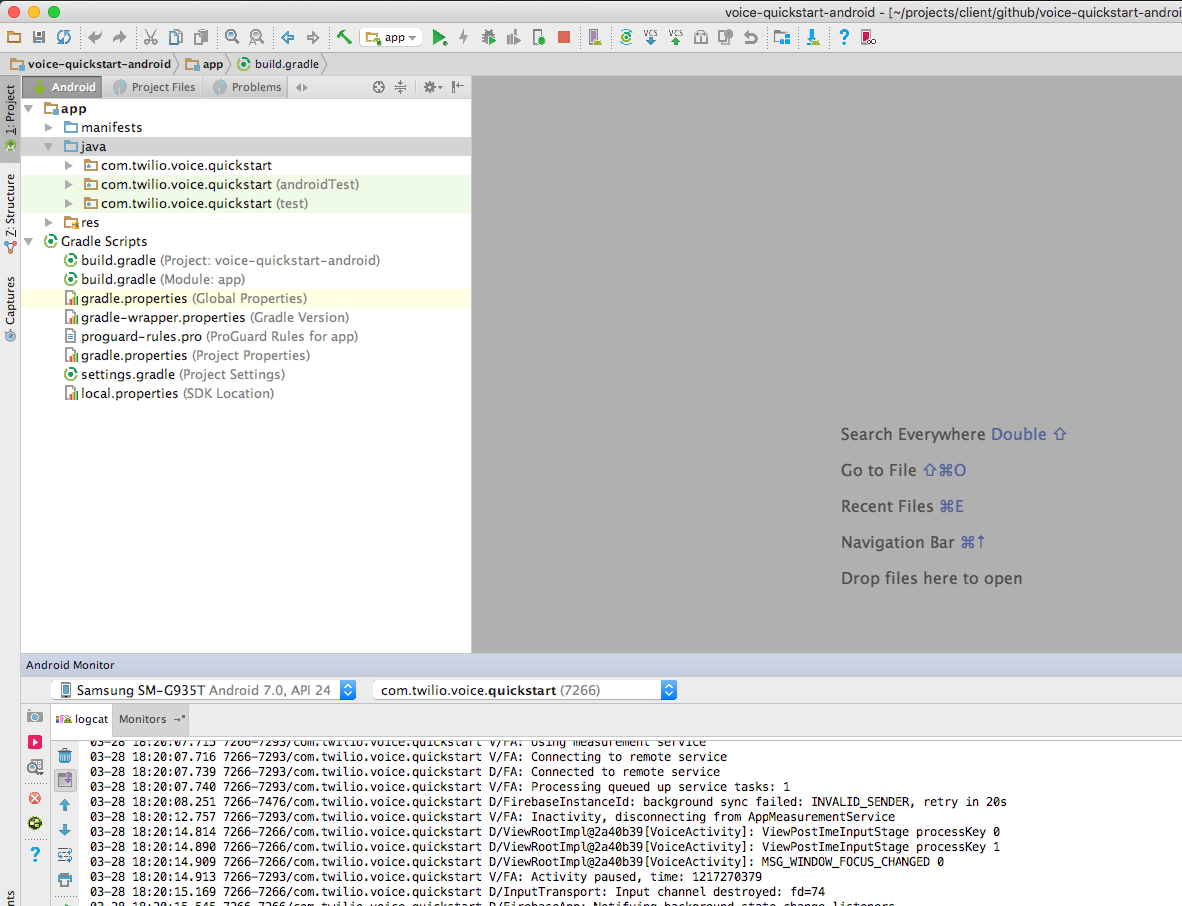 60 |
61 | ### 3. Use Twilio CLI to deploy access token and TwiML application to Twilio Serverless
62 |
63 | You must have the following installed:
64 |
65 | * [Node.js v10+](https://nodejs.org/en/download/)
66 | * NPM v6+ (comes installed with newer Node versions)
67 |
68 | Run `npm install` to install all dependencies from NPM.
69 |
70 | Install [twilio-cli](https://www.twilio.com/docs/twilio-cli/quickstart) with:
71 |
72 | $ npm install -g twilio-cli
73 |
74 | Login to the Twilio CLI. You will be prompted for your Account SID and Auth Token, both of which you can find on the dashboard of your [Twilio console](https://twilio.com/console).
75 |
76 | $ twilio login
77 |
78 | Once successfully logged in, an API Key, a secret get created and stored in your keychain as the twilio-cli password in `SKxxxx|secret` format. Please make a note of these values to use them in the `Server/.env` file.
79 |
80 |
60 |
61 | ### 3. Use Twilio CLI to deploy access token and TwiML application to Twilio Serverless
62 |
63 | You must have the following installed:
64 |
65 | * [Node.js v10+](https://nodejs.org/en/download/)
66 | * NPM v6+ (comes installed with newer Node versions)
67 |
68 | Run `npm install` to install all dependencies from NPM.
69 |
70 | Install [twilio-cli](https://www.twilio.com/docs/twilio-cli/quickstart) with:
71 |
72 | $ npm install -g twilio-cli
73 |
74 | Login to the Twilio CLI. You will be prompted for your Account SID and Auth Token, both of which you can find on the dashboard of your [Twilio console](https://twilio.com/console).
75 |
76 | $ twilio login
77 |
78 | Once successfully logged in, an API Key, a secret get created and stored in your keychain as the twilio-cli password in `SKxxxx|secret` format. Please make a note of these values to use them in the `Server/.env` file.
79 |
80 | 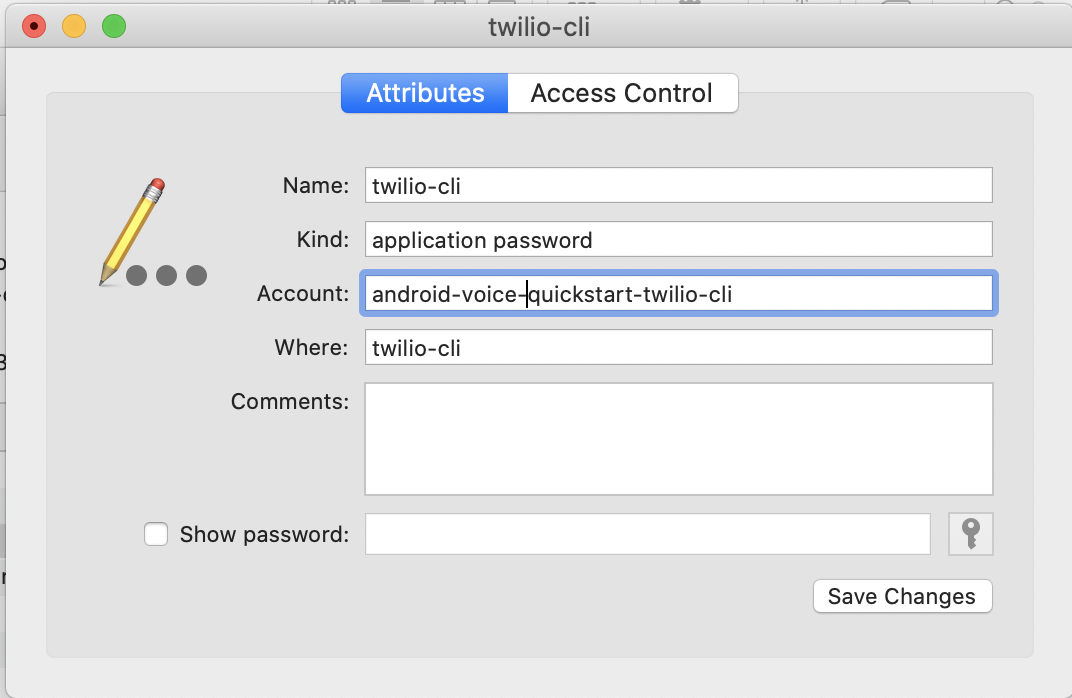 81 |
82 | This app requires the [Serverless plug-in](https://github.com/twilio-labs/plugin-serverless). Install the CLI plugin with:
83 |
84 | $ twilio plugins:install @twilio-labs/plugin-serverless
85 |
86 | Before deploying, create a `Server/.env` by copying from `Server/.env.example`
87 |
88 | $ cp Server/.env.example Server/.env
89 |
90 | Update `Server/.env` with your Account SID, auth token, API Key and secret.
91 |
92 | ACCOUNT_SID=ACxxxx
93 | AUTH_TOKEN=xxxxxx
94 | API_KEY_SID=SKxxxx
95 | API_SECRET=xxxxxx
96 | APP_SID=APxxxx(available in step 4)
97 | PUSH_CREDENTIAL_SID=CRxxxx(available in step 7)
98 |
99 | The `Server` folder contains a basic server component which can be used to vend access tokens or generate TwiML response for making call to a number or another client. The app is deployed to Twilio Serverless with the `serverless` plug-in:
100 |
101 | $ cd Server
102 | $ twilio serverless:deploy
103 |
104 | The server component that's baked into this quickstart is in Node.js. If you’d like to roll your own or better understand the Twilio Voice server side implementations, please see the list of starter projects in the following supported languages below:
105 |
106 | * [voice-quickstart-server-java](https://github.com/twilio/voice-quickstart-server-java)
107 | * [voice-quickstart-server-node](https://github.com/twilio/voice-quickstart-server-node)
108 | * [voice-quickstart-server-php](https://github.com/twilio/voice-quickstart-server-php)
109 | * [voice-quickstart-server-python](https://github.com/twilio/voice-quickstart-server-python)
110 |
111 | Follow the instructions in the project's README to get the application server up and running locally and accessible via the public Internet.
112 |
113 | ### 4. Create a TwiML application for the Access Token
114 |
115 | Next, we need to create a TwiML application. A TwiML application identifies a public URL for retrieving [TwiML call control instructions](https://www.twilio.com/docs/voice/twiml). When your QS app makes a call to the Twilio cloud, Twilio will make a webhook request to this URL, your application server will respond with generated TwiML, and Twilio will execute the instructions you’ve provided.
116 |
117 | Use Twilio CLI to create a TwiML app with the `make-call` endpoint you have just deployed (**Note: replace the value of `--voice-url` parameter with your `make-call` endpoint you just deployed to Twilio Serverless**)
118 |
119 | $ twilio api:core:applications:create \
120 | --friendly-name=my-twiml-app \
121 | --voice-method=POST \
122 | --voice-url="https://my-quickstart-dev.twil.io/make-call"
123 |
124 | You should receive an Appliciation SID that looks like this
125 |
126 | APxxxxxxxxxxxxxxxxxxxxxxxxxxxxxxxx
127 |
128 | ### 5. Generate an access token for the quickstart
129 |
130 | Install the `token` plug-in
131 |
132 | $ twilio plugins:install @twilio-labs/plugin-token
133 |
134 | Use the TwiML App SID you just created to generate an access token
135 |
136 | $ twilio token:voice --identity=alice --voice-app-sid=APxxxxxxxxxxxxxxxxxxxxxxxxxxxxxxxx
137 |
138 | Copy the access token string. Your Android app will use this token to connect to Twilio.
139 |
140 |
141 | ### 6. Run the app
142 |
143 | Now let’s go back to the `app`, update the placeholder of `accessToken` with access token string you just copied in `VoiceActivity.java`.
144 |
145 | ```
146 | private String accessToken = "PASTE_YOUR_ACCESS_TOKEN_HERE";
147 | ```
148 |
149 | Build and run the quickstart app on an Android device.
150 |
151 |
81 |
82 | This app requires the [Serverless plug-in](https://github.com/twilio-labs/plugin-serverless). Install the CLI plugin with:
83 |
84 | $ twilio plugins:install @twilio-labs/plugin-serverless
85 |
86 | Before deploying, create a `Server/.env` by copying from `Server/.env.example`
87 |
88 | $ cp Server/.env.example Server/.env
89 |
90 | Update `Server/.env` with your Account SID, auth token, API Key and secret.
91 |
92 | ACCOUNT_SID=ACxxxx
93 | AUTH_TOKEN=xxxxxx
94 | API_KEY_SID=SKxxxx
95 | API_SECRET=xxxxxx
96 | APP_SID=APxxxx(available in step 4)
97 | PUSH_CREDENTIAL_SID=CRxxxx(available in step 7)
98 |
99 | The `Server` folder contains a basic server component which can be used to vend access tokens or generate TwiML response for making call to a number or another client. The app is deployed to Twilio Serverless with the `serverless` plug-in:
100 |
101 | $ cd Server
102 | $ twilio serverless:deploy
103 |
104 | The server component that's baked into this quickstart is in Node.js. If you’d like to roll your own or better understand the Twilio Voice server side implementations, please see the list of starter projects in the following supported languages below:
105 |
106 | * [voice-quickstart-server-java](https://github.com/twilio/voice-quickstart-server-java)
107 | * [voice-quickstart-server-node](https://github.com/twilio/voice-quickstart-server-node)
108 | * [voice-quickstart-server-php](https://github.com/twilio/voice-quickstart-server-php)
109 | * [voice-quickstart-server-python](https://github.com/twilio/voice-quickstart-server-python)
110 |
111 | Follow the instructions in the project's README to get the application server up and running locally and accessible via the public Internet.
112 |
113 | ### 4. Create a TwiML application for the Access Token
114 |
115 | Next, we need to create a TwiML application. A TwiML application identifies a public URL for retrieving [TwiML call control instructions](https://www.twilio.com/docs/voice/twiml). When your QS app makes a call to the Twilio cloud, Twilio will make a webhook request to this URL, your application server will respond with generated TwiML, and Twilio will execute the instructions you’ve provided.
116 |
117 | Use Twilio CLI to create a TwiML app with the `make-call` endpoint you have just deployed (**Note: replace the value of `--voice-url` parameter with your `make-call` endpoint you just deployed to Twilio Serverless**)
118 |
119 | $ twilio api:core:applications:create \
120 | --friendly-name=my-twiml-app \
121 | --voice-method=POST \
122 | --voice-url="https://my-quickstart-dev.twil.io/make-call"
123 |
124 | You should receive an Appliciation SID that looks like this
125 |
126 | APxxxxxxxxxxxxxxxxxxxxxxxxxxxxxxxx
127 |
128 | ### 5. Generate an access token for the quickstart
129 |
130 | Install the `token` plug-in
131 |
132 | $ twilio plugins:install @twilio-labs/plugin-token
133 |
134 | Use the TwiML App SID you just created to generate an access token
135 |
136 | $ twilio token:voice --identity=alice --voice-app-sid=APxxxxxxxxxxxxxxxxxxxxxxxxxxxxxxxx
137 |
138 | Copy the access token string. Your Android app will use this token to connect to Twilio.
139 |
140 |
141 | ### 6. Run the app
142 |
143 | Now let’s go back to the `app`, update the placeholder of `accessToken` with access token string you just copied in `VoiceActivity.java`.
144 |
145 | ```
146 | private String accessToken = "PASTE_YOUR_ACCESS_TOKEN_HERE";
147 | ```
148 |
149 | Build and run the quickstart app on an Android device.
150 |
151 | 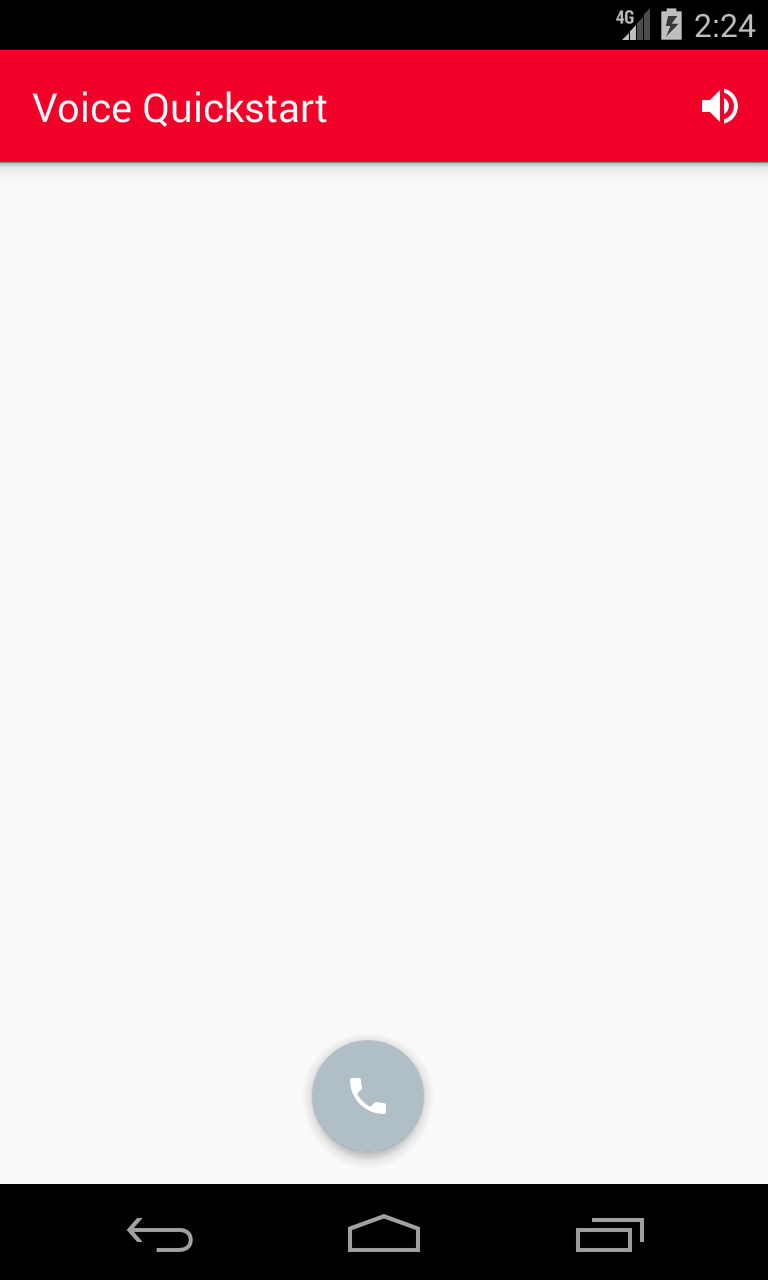 152 |
153 | Press the call button to open the call dialog.
154 |
155 |
152 |
153 | Press the call button to open the call dialog.
154 |
155 | 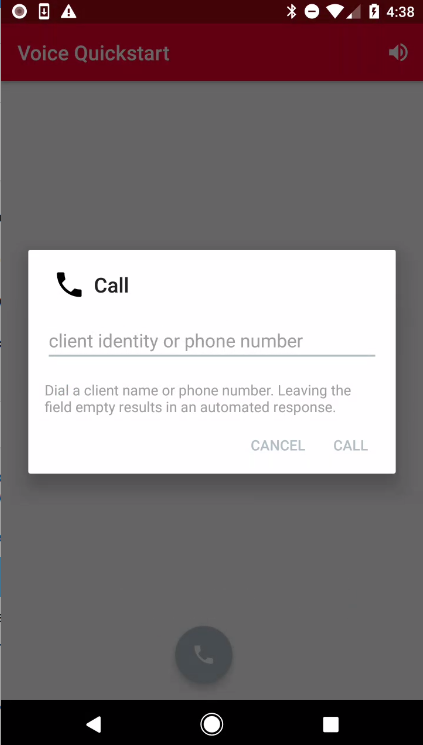 156 |
157 | Leave the dialog text field empty and press the call button to start a call. You will hear the congratulatory message. Support for dialing another client or number is described in steps 9 and 10.
158 |
159 |
156 |
157 | Leave the dialog text field empty and press the call button to start a call. You will hear the congratulatory message. Support for dialing another client or number is described in steps 9 and 10.
158 |
159 | 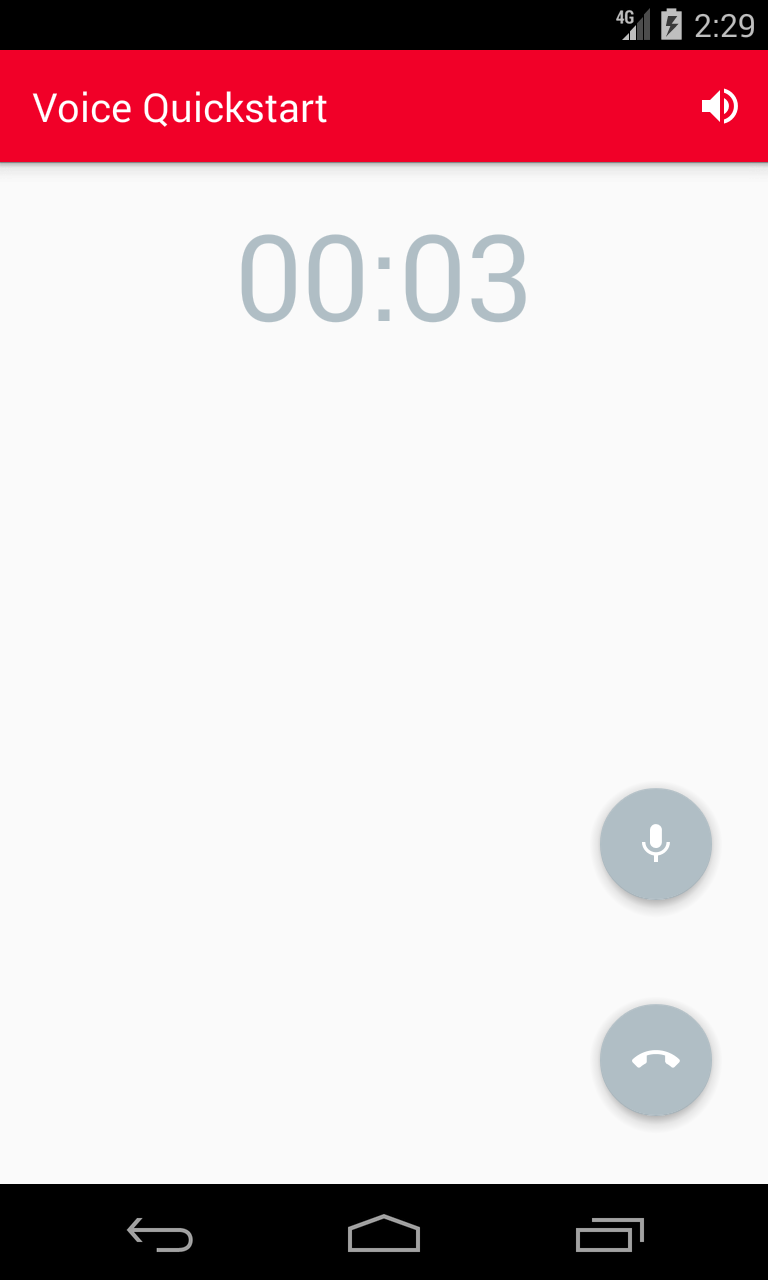 160 |
161 |
162 | ### 7. Create a Push Credential using your FCM Server Key
163 |
164 | You will need to store the FCM Server key(The **Server key** of your project from the Firebase console, found under Settings/Cloud messaging) with Twilio so that we can send push notifications to your app on your behalf. Once you store the Server key with Twilio, it will get assigned a Push Credential SID so that you can later specify which key we should use to send push notifications.
165 |
166 | A FCMv1 server key can be generated from a Firebase Service account by selecting `Create New Key` and subsequently selecting a 'JSON' key type. Keep track of this generated key due to its limited accessibility. For more information on how to create a FCMv1 token, please follow this [document](https://help.twilio.com/articles/20768292997147-Updating-Twilio-Push-for-FCM-HTTP-v1-API).
167 |
168 |
160 |
161 |
162 | ### 7. Create a Push Credential using your FCM Server Key
163 |
164 | You will need to store the FCM Server key(The **Server key** of your project from the Firebase console, found under Settings/Cloud messaging) with Twilio so that we can send push notifications to your app on your behalf. Once you store the Server key with Twilio, it will get assigned a Push Credential SID so that you can later specify which key we should use to send push notifications.
165 |
166 | A FCMv1 server key can be generated from a Firebase Service account by selecting `Create New Key` and subsequently selecting a 'JSON' key type. Keep track of this generated key due to its limited accessibility. For more information on how to create a FCMv1 token, please follow this [document](https://help.twilio.com/articles/20768292997147-Updating-Twilio-Push-for-FCM-HTTP-v1-API).
167 |
168 | 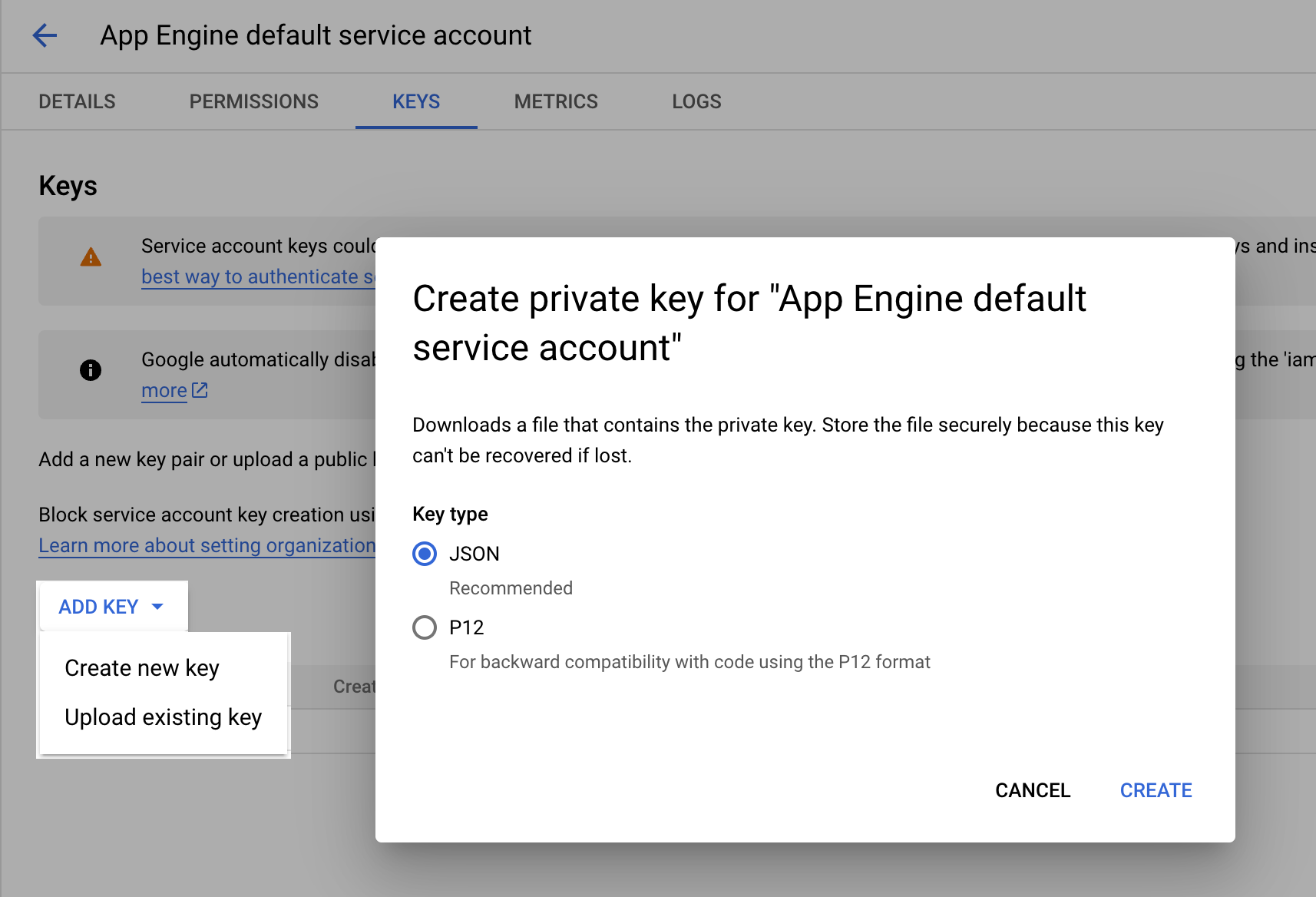 169 |
170 | Once that token is created, go to your Twilio Console and from the "Account" drop-down on the upper right, select "Credentials".
171 |
172 |
169 |
170 | Once that token is created, go to your Twilio Console and from the "Account" drop-down on the upper right, select "Credentials".
171 |
172 |  173 |
174 | From the within the "Credentials" page, select the tab labeled "Push Credentials" and then click the large "+" button.
175 |
176 |
173 |
174 | From the within the "Credentials" page, select the tab labeled "Push Credentials" and then click the large "+" button.
175 |
176 |  177 |
178 | After providing a friendly name, from the drop-down menu labeled "Type" select "FCM Push Credentials" and paste the key you generated in Firebase in the third box labeled "FCM Secret". Under the list of created "Push Credentials" you should now find your new push credential SID.
179 |
180 |
177 |
178 | After providing a friendly name, from the drop-down menu labeled "Type" select "FCM Push Credentials" and paste the key you generated in Firebase in the third box labeled "FCM Secret". Under the list of created "Push Credentials" you should now find your new push credential SID.
179 |
180 |  181 |
182 | The newly created Push Credential SID should look like this
183 |
184 | CRxxxxxxxxxxxxxxxxxxxxxxxxxxxxxxxx
185 |
186 | Now let's generate another access token and add the Push Credential to the Voice Grant.
187 |
188 | $ twilio token:voice \
189 | --identity=alice \
190 | --voice-app-sid=APxxxx \
191 | --push-credential-sid=CRxxxxs
192 |
193 |
194 | ### 8. Receiving an Incoming Notification
195 |
196 | You are now ready to receive incoming calls. Update your app with the access token generated from step 7 and rebuild your app. The `Voice.register()` method will register your mobile application with the FCM device token as well as the access token. Once registered, hit your application server's **/place-call** endpoint: `https://my-quickstart-dev.twil.io/place-call?to=alice`. This will trigger a Twilio REST API request that will make an inbound call to your mobile app.
197 |
198 | Your application will be brought to the foreground and you will see an alert dialog. The app will be brought to foreground even when your screen is locked.
199 |
200 |
181 |
182 | The newly created Push Credential SID should look like this
183 |
184 | CRxxxxxxxxxxxxxxxxxxxxxxxxxxxxxxxx
185 |
186 | Now let's generate another access token and add the Push Credential to the Voice Grant.
187 |
188 | $ twilio token:voice \
189 | --identity=alice \
190 | --voice-app-sid=APxxxx \
191 | --push-credential-sid=CRxxxxs
192 |
193 |
194 | ### 8. Receiving an Incoming Notification
195 |
196 | You are now ready to receive incoming calls. Update your app with the access token generated from step 7 and rebuild your app. The `Voice.register()` method will register your mobile application with the FCM device token as well as the access token. Once registered, hit your application server's **/place-call** endpoint: `https://my-quickstart-dev.twil.io/place-call?to=alice`. This will trigger a Twilio REST API request that will make an inbound call to your mobile app.
197 |
198 | Your application will be brought to the foreground and you will see an alert dialog. The app will be brought to foreground even when your screen is locked.
199 |
200 | 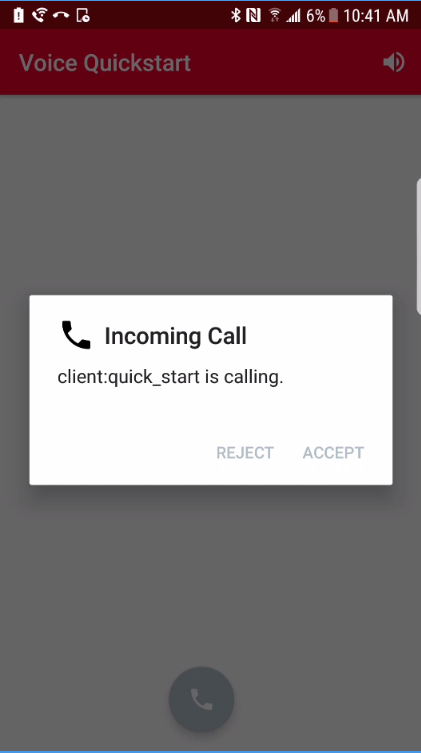 "
201 |
202 | Once your app accepts the call, you should hear a congratulatory message.
203 |
204 | ### 9. Make client to client call
205 |
206 | To make client to client calls, you need the application running on two devices. To run the application on an additional device, make sure you use a different identity in your access token when registering the new device.
207 |
208 | Press the call button to open the call dialog.
209 |
210 |
"
201 |
202 | Once your app accepts the call, you should hear a congratulatory message.
203 |
204 | ### 9. Make client to client call
205 |
206 | To make client to client calls, you need the application running on two devices. To run the application on an additional device, make sure you use a different identity in your access token when registering the new device.
207 |
208 | Press the call button to open the call dialog.
209 |
210 | 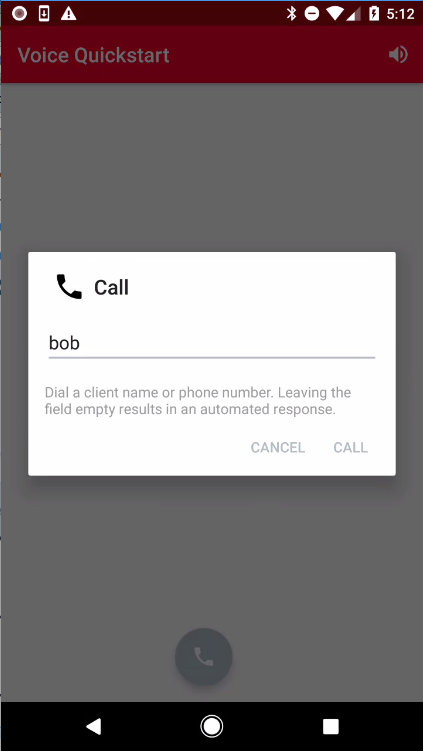 215 |
215 | 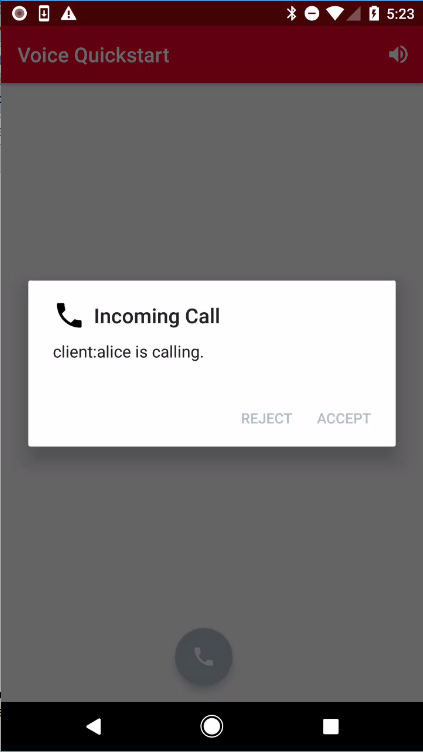 216 |
217 | ### 10. Make client to PSTN call
218 |
219 | A verified phone number is one that you can use as your Caller ID when making outbound calls with Twilio. This number has not been ported into Twilio and you do not pay Twilio for this phone number.
220 |
221 | To make client to number calls, first get a valid Twilio number to your account via https://www.twilio.com/console/phone-numbers/verified. Update your server code and replace the `callerNumber` with the verified number. Restart the server so that it uses the new value.
222 |
223 | Press the call button to open the call dialog.
224 |
225 |
216 |
217 | ### 10. Make client to PSTN call
218 |
219 | A verified phone number is one that you can use as your Caller ID when making outbound calls with Twilio. This number has not been ported into Twilio and you do not pay Twilio for this phone number.
220 |
221 | To make client to number calls, first get a valid Twilio number to your account via https://www.twilio.com/console/phone-numbers/verified. Update your server code and replace the `callerNumber` with the verified number. Restart the server so that it uses the new value.
222 |
223 | Press the call button to open the call dialog.
224 |
225 |  230 |
231 | ## Examples
232 | In addition to the quickstart we've also added an example that shows how to create and customize media experience in your app:
233 |
234 | - [Custom Audio Device](https://github.com/twilio/voice-quickstart-android/tree/master/exampleCustomAudioDevice) - Demonstrates how to use Twilio's Programmable Voice SDK with audio playback and recording functionality provided by a custom `AudioDevice`.
235 |
236 | ## More Documentation
237 |
238 | You can find more documentation on getting started as well as our latest Javadoc below:
239 |
240 |
241 | * [Getting Started](https://www.twilio.com/docs/voice/sdks/android/get-started)
242 | * [Javadoc](https://media.twiliocdn.com/sdk/android/voice/latest/docs/)
243 |
244 | ## Twilio Helper Libraries
245 |
246 | To learn more about how to use TwiML and the Programmable Voice Calls API, check out our TwiML quickstarts:
247 |
248 | * [TwiML Quickstart for Python](https://www.twilio.com/docs/voice/quickstart/python)
249 | * [TwiML Quickstart for Ruby](https://www.twilio.com/docs/voice/quickstart/ruby)
250 | * [TwiML Quickstart for PHP](https://www.twilio.com/docs/voice/quickstart/php)
251 | * [TwiML Quickstart for Java](https://www.twilio.com/docs/voice/quickstart/java)
252 | * [TwiML Quickstart for C#](https://www.twilio.com/docs/voice/quickstart/csharp)
253 |
254 | ## Issues and Support
255 |
256 | Please file any issues you find here on Github.
257 | For general inquiries related to the Voice SDK you can file a support ticket.
258 | Please ensure that you are not sharing any
259 | [Personally Identifiable Information(PII)](https://www.twilio.com/docs/glossary/what-is-personally-identifiable-information-pii)
260 | or sensitive account information (API keys, credentials, etc.) when reporting an issue.
261 |
262 | ## License
263 | MIT
264 |
--------------------------------------------------------------------------------
/Server/.env.example:
--------------------------------------------------------------------------------
1 | ACCOUNT_SID=ACxxxx
2 | AUTH_TOKEN=xxxxxx
3 | API_KEY_SID=SKxxxx
4 | API_SECRET=xxxxxx
5 | APP_SID=APxxxx
6 | PUSH_CREDENTIAL_SID=CRxxxx
7 |
--------------------------------------------------------------------------------
/Server/.gitignore:
--------------------------------------------------------------------------------
1 | .DS_Store
2 | .env
3 | npm-debug.log
4 | node_modules
5 | .twilio-functions
6 |
--------------------------------------------------------------------------------
/Server/.nvmrc:
--------------------------------------------------------------------------------
1 | v16.20.1
2 |
--------------------------------------------------------------------------------
/Server/LICENSE:
--------------------------------------------------------------------------------
1 | MIT License
2 |
3 | Copyright (c) 2021 Twilio Inc.
4 |
5 | Permission is hereby granted, free of charge, to any person obtaining a copy
6 | of this software and associated documentation files (the "Software"), to deal
7 | in the Software without restriction, including without limitation the rights
8 | to use, copy, modify, merge, publish, distribute, sublicense, and/or sell
9 | copies of the Software, and to permit persons to whom the Software is
10 | furnished to do so, subject to the following conditions:
11 |
12 | The above copyright notice and this permission notice shall be included in all
13 | copies or substantial portions of the Software.
14 |
15 | THE SOFTWARE IS PROVIDED "AS IS", WITHOUT WARRANTY OF ANY KIND, EXPRESS OR
16 | IMPLIED, INCLUDING BUT NOT LIMITED TO THE WARRANTIES OF MERCHANTABILITY,
17 | FITNESS FOR A PARTICULAR PURPOSE AND NONINFRINGEMENT. IN NO EVENT SHALL THE
18 | AUTHORS OR COPYRIGHT HOLDERS BE LIABLE FOR ANY CLAIM, DAMAGES OR OTHER
19 | LIABILITY, WHETHER IN AN ACTION OF CONTRACT, TORT OR OTHERWISE, ARISING FROM,
20 | OUT OF OR IN CONNECTION WITH THE SOFTWARE OR THE USE OR OTHER DEALINGS IN THE
21 | SOFTWARE.
22 |
--------------------------------------------------------------------------------
/Server/assets/index.html:
--------------------------------------------------------------------------------
1 |
2 |
3 |
4 |
5 |
6 |
7 |
8 |
230 |
231 | ## Examples
232 | In addition to the quickstart we've also added an example that shows how to create and customize media experience in your app:
233 |
234 | - [Custom Audio Device](https://github.com/twilio/voice-quickstart-android/tree/master/exampleCustomAudioDevice) - Demonstrates how to use Twilio's Programmable Voice SDK with audio playback and recording functionality provided by a custom `AudioDevice`.
235 |
236 | ## More Documentation
237 |
238 | You can find more documentation on getting started as well as our latest Javadoc below:
239 |
240 |
241 | * [Getting Started](https://www.twilio.com/docs/voice/sdks/android/get-started)
242 | * [Javadoc](https://media.twiliocdn.com/sdk/android/voice/latest/docs/)
243 |
244 | ## Twilio Helper Libraries
245 |
246 | To learn more about how to use TwiML and the Programmable Voice Calls API, check out our TwiML quickstarts:
247 |
248 | * [TwiML Quickstart for Python](https://www.twilio.com/docs/voice/quickstart/python)
249 | * [TwiML Quickstart for Ruby](https://www.twilio.com/docs/voice/quickstart/ruby)
250 | * [TwiML Quickstart for PHP](https://www.twilio.com/docs/voice/quickstart/php)
251 | * [TwiML Quickstart for Java](https://www.twilio.com/docs/voice/quickstart/java)
252 | * [TwiML Quickstart for C#](https://www.twilio.com/docs/voice/quickstart/csharp)
253 |
254 | ## Issues and Support
255 |
256 | Please file any issues you find here on Github.
257 | For general inquiries related to the Voice SDK you can file a support ticket.
258 | Please ensure that you are not sharing any
259 | [Personally Identifiable Information(PII)](https://www.twilio.com/docs/glossary/what-is-personally-identifiable-information-pii)
260 | or sensitive account information (API keys, credentials, etc.) when reporting an issue.
261 |
262 | ## License
263 | MIT
264 |
--------------------------------------------------------------------------------
/Server/.env.example:
--------------------------------------------------------------------------------
1 | ACCOUNT_SID=ACxxxx
2 | AUTH_TOKEN=xxxxxx
3 | API_KEY_SID=SKxxxx
4 | API_SECRET=xxxxxx
5 | APP_SID=APxxxx
6 | PUSH_CREDENTIAL_SID=CRxxxx
7 |
--------------------------------------------------------------------------------
/Server/.gitignore:
--------------------------------------------------------------------------------
1 | .DS_Store
2 | .env
3 | npm-debug.log
4 | node_modules
5 | .twilio-functions
6 |
--------------------------------------------------------------------------------
/Server/.nvmrc:
--------------------------------------------------------------------------------
1 | v16.20.1
2 |
--------------------------------------------------------------------------------
/Server/LICENSE:
--------------------------------------------------------------------------------
1 | MIT License
2 |
3 | Copyright (c) 2021 Twilio Inc.
4 |
5 | Permission is hereby granted, free of charge, to any person obtaining a copy
6 | of this software and associated documentation files (the "Software"), to deal
7 | in the Software without restriction, including without limitation the rights
8 | to use, copy, modify, merge, publish, distribute, sublicense, and/or sell
9 | copies of the Software, and to permit persons to whom the Software is
10 | furnished to do so, subject to the following conditions:
11 |
12 | The above copyright notice and this permission notice shall be included in all
13 | copies or substantial portions of the Software.
14 |
15 | THE SOFTWARE IS PROVIDED "AS IS", WITHOUT WARRANTY OF ANY KIND, EXPRESS OR
16 | IMPLIED, INCLUDING BUT NOT LIMITED TO THE WARRANTIES OF MERCHANTABILITY,
17 | FITNESS FOR A PARTICULAR PURPOSE AND NONINFRINGEMENT. IN NO EVENT SHALL THE
18 | AUTHORS OR COPYRIGHT HOLDERS BE LIABLE FOR ANY CLAIM, DAMAGES OR OTHER
19 | LIABILITY, WHETHER IN AN ACTION OF CONTRACT, TORT OR OTHERWISE, ARISING FROM,
20 | OUT OF OR IN CONNECTION WITH THE SOFTWARE OR THE USE OR OTHER DEALINGS IN THE
21 | SOFTWARE.
22 |
--------------------------------------------------------------------------------
/Server/assets/index.html:
--------------------------------------------------------------------------------
1 |
2 |
3 |
4 |
5 |
6 |
7 |
8 |  13 |
14 | ### Setup
15 |
16 | Refer to the [README](https://github.com/twilio/voice-quickstart-android/blob/master/README.md) for instructions on how to generate an access token and make an outbound `Call`.
17 | In [step 6](https://github.com/twilio/voice-quickstart-android#6-run-the-app), update the placeholder of `accessToken` with access token string you copied in `CustomDeviceActivity.java`.
18 |
19 |
20 | ### Running
21 |
22 | Once you have configured your access token, build and run the example. Press the call button to open the call dialog and make an outbound call to a [client](https://github.com/twilio/voice-quickstart-android#bullet10) or to a [PSTN](https://github.com/twilio/voice-quickstart-android#11-make-client-to-pstn-call) number.
23 |
24 |
13 |
14 | ### Setup
15 |
16 | Refer to the [README](https://github.com/twilio/voice-quickstart-android/blob/master/README.md) for instructions on how to generate an access token and make an outbound `Call`.
17 | In [step 6](https://github.com/twilio/voice-quickstart-android#6-run-the-app), update the placeholder of `accessToken` with access token string you copied in `CustomDeviceActivity.java`.
18 |
19 |
20 | ### Running
21 |
22 | Once you have configured your access token, build and run the example. Press the call button to open the call dialog and make an outbound call to a [client](https://github.com/twilio/voice-quickstart-android#bullet10) or to a [PSTN](https://github.com/twilio/voice-quickstart-android#11-make-client-to-pstn-call) number.
23 |
24 |  25 |
26 | Audio from a file is selected by default. Once the Call is connected, music starts to play.
27 |
28 |
25 |
26 | Audio from a file is selected by default. Once the Call is connected, music starts to play.
27 |
28 |  29 |
30 | You can switch to microphone by clicking the `♫` button.
31 |
32 |
29 |
30 | You can switch to microphone by clicking the `♫` button.
31 |
32 |  33 |
34 | Note: The switch between audio file and microphone always starts the music from the begining of the file.
35 |
36 | ## Troubleshooting Audio
37 | The following sections provide guidance on how to ensure optimal audio quality in your applications using default audio device.
38 |
39 | ### Configuring AudioManager
40 |
41 | Follow the [README](https://github.com/twilio/voice-quickstart-android#configuring-audiomanager) to configure audio manager.
42 |
43 | ### Configuring Hardware Audio Effects Using Custom Audio Device
44 | Our library performs acoustic echo cancellation (AEC) and noise suppression (NS) using device hardware by default. Using device hardware is more efficient, but some devices do not implement these audio effects well. If you are experiencing echo or background noise on certain devices reference the following snippet for enabling software implementations of AEC and NS.
45 |
46 | /*
47 | * Execute any time before invoking `Voice.connect(...)` or `CallInvite.accept(...)`.
48 | */
49 |
50 | // Use software AEC
51 | DefaultAudioDevice defaultAudioDevice = new DefaultAudioDevice();
52 | defaultAudioDevice.setUseHardwareAcousticEchoCanceler(false);
53 | Voice.setAudioDevice(defaultAudioDevice);
54 |
55 | // Use sofware NS
56 | DefaultAudioDevice defaultAudioDevice = new DefaultAudioDevice();
57 | defaultAudioDevice.setUseHardwareNoiseSuppressor(false);
58 | Voice.setAudioDevice(defaultAudioDevice);
59 |
60 | ### Configuring OpenSL ES
61 | Follow the [README](https://github.com/twilio/voice-quickstart-android#configuring-opensl-es) to configure OpenSL ES.
62 |
63 | ### Managing Device Specific Configurations
64 | Follow the [README](https://github.com/twilio/voice-quickstart-android#managing-device-specific-configurations) to manage device specific configurations.
65 |
66 | ### Handling Low Headset Volume
67 | Follow the [README](https://github.com/twilio/voice-quickstart-android#handling-low-headset-volume) to handle low handset volume.
68 |
--------------------------------------------------------------------------------
/exampleCustomAudioDevice/build.gradle:
--------------------------------------------------------------------------------
1 | apply plugin: 'com.android.application'
2 |
3 | android {
4 | namespace 'com.twilio.examplecustomaudiodevice'
5 | compileSdkVersion versions.compileSdk
6 | buildToolsVersion versions.buildTools
7 |
8 | compileOptions {
9 | sourceCompatibility versions.java
10 | targetCompatibility versions.java
11 | }
12 |
13 | defaultConfig {
14 | applicationId "com.twilio.examplecustomaudiodevice"
15 | minSdkVersion versions.minSdk
16 | targetSdkVersion versions.targetSdk
17 | versionCode 1
18 | versionName "1.0"
19 | }
20 |
21 | buildFeatures {
22 | buildConfig = true
23 | }
24 |
25 | buildTypes {
26 | release {
27 | minifyEnabled true
28 | proguardFiles getDefaultProguardFile('proguard-android.txt'), 'proguard-rules.pro'
29 | signingConfig signingConfigs.debug
30 | }
31 | }
32 |
33 | // Specify that we want to split up the APK based on ABI
34 | splits {
35 | abi {
36 | // Enable ABI split
37 | enable true
38 |
39 | // Clear list of ABIs
40 | reset()
41 |
42 | // Specify each architecture currently supported by the Video SDK
43 | include "armeabi-v7a", "arm64-v8a", "x86", "x86_64"
44 |
45 | // Specify that we do not want an additional universal SDK
46 | universalApk false
47 | }
48 | }
49 | }
50 |
51 | dependencies {
52 | implementation "com.twilio:voice-android:${versions.voiceAndroid}"
53 | implementation "com.google.android.material:material:${versions.material}"
54 | implementation "androidx.lifecycle:lifecycle-extensions:${versions.androidxLifecycle}"
55 | androidTestImplementation "androidx.test.ext:junit:${versions.junit}"
56 | }
--------------------------------------------------------------------------------
/exampleCustomAudioDevice/gradle.properties:
--------------------------------------------------------------------------------
1 | android.useAndroidX=true
2 | android.enableJetifier=true
--------------------------------------------------------------------------------
/exampleCustomAudioDevice/libs/voice-release.aar:
--------------------------------------------------------------------------------
https://raw.githubusercontent.com/twilio/voice-quickstart-android/7b21f077e5ea2b5e2619c759960278f9922b4397/exampleCustomAudioDevice/libs/voice-release.aar
--------------------------------------------------------------------------------
/exampleCustomAudioDevice/proguard-rules.pro:
--------------------------------------------------------------------------------
1 | # Add project specific ProGuard rules here.
2 | # You can control the set of applied configuration files using the
3 | # proguardFiles setting in build.gradle.
4 | #
5 | # For more details, see
6 | # http://developer.android.com/guide/developing/tools/proguard.html
7 |
8 | # If your project uses WebView with JS, uncomment the following
9 | # and specify the fully qualified class name to the JavaScript interface
10 | # class:
11 | #-keepclassmembers class fqcn.of.javascript.interface.for.webview {
12 | # public *;
13 | #}
14 |
15 | # Uncomment this to preserve the line number information for
16 | # debugging stack traces.
17 | #-keepattributes SourceFile,LineNumberTable
18 |
19 | # If you keep the line number information, uncomment this to
20 | # hide the original source file name.
21 | #-renamesourcefileattribute SourceFile
22 |
--------------------------------------------------------------------------------
/exampleCustomAudioDevice/src/main/AndroidManifest.xml:
--------------------------------------------------------------------------------
1 |
33 |
34 | Note: The switch between audio file and microphone always starts the music from the begining of the file.
35 |
36 | ## Troubleshooting Audio
37 | The following sections provide guidance on how to ensure optimal audio quality in your applications using default audio device.
38 |
39 | ### Configuring AudioManager
40 |
41 | Follow the [README](https://github.com/twilio/voice-quickstart-android#configuring-audiomanager) to configure audio manager.
42 |
43 | ### Configuring Hardware Audio Effects Using Custom Audio Device
44 | Our library performs acoustic echo cancellation (AEC) and noise suppression (NS) using device hardware by default. Using device hardware is more efficient, but some devices do not implement these audio effects well. If you are experiencing echo or background noise on certain devices reference the following snippet for enabling software implementations of AEC and NS.
45 |
46 | /*
47 | * Execute any time before invoking `Voice.connect(...)` or `CallInvite.accept(...)`.
48 | */
49 |
50 | // Use software AEC
51 | DefaultAudioDevice defaultAudioDevice = new DefaultAudioDevice();
52 | defaultAudioDevice.setUseHardwareAcousticEchoCanceler(false);
53 | Voice.setAudioDevice(defaultAudioDevice);
54 |
55 | // Use sofware NS
56 | DefaultAudioDevice defaultAudioDevice = new DefaultAudioDevice();
57 | defaultAudioDevice.setUseHardwareNoiseSuppressor(false);
58 | Voice.setAudioDevice(defaultAudioDevice);
59 |
60 | ### Configuring OpenSL ES
61 | Follow the [README](https://github.com/twilio/voice-quickstart-android#configuring-opensl-es) to configure OpenSL ES.
62 |
63 | ### Managing Device Specific Configurations
64 | Follow the [README](https://github.com/twilio/voice-quickstart-android#managing-device-specific-configurations) to manage device specific configurations.
65 |
66 | ### Handling Low Headset Volume
67 | Follow the [README](https://github.com/twilio/voice-quickstart-android#handling-low-headset-volume) to handle low handset volume.
68 |
--------------------------------------------------------------------------------
/exampleCustomAudioDevice/build.gradle:
--------------------------------------------------------------------------------
1 | apply plugin: 'com.android.application'
2 |
3 | android {
4 | namespace 'com.twilio.examplecustomaudiodevice'
5 | compileSdkVersion versions.compileSdk
6 | buildToolsVersion versions.buildTools
7 |
8 | compileOptions {
9 | sourceCompatibility versions.java
10 | targetCompatibility versions.java
11 | }
12 |
13 | defaultConfig {
14 | applicationId "com.twilio.examplecustomaudiodevice"
15 | minSdkVersion versions.minSdk
16 | targetSdkVersion versions.targetSdk
17 | versionCode 1
18 | versionName "1.0"
19 | }
20 |
21 | buildFeatures {
22 | buildConfig = true
23 | }
24 |
25 | buildTypes {
26 | release {
27 | minifyEnabled true
28 | proguardFiles getDefaultProguardFile('proguard-android.txt'), 'proguard-rules.pro'
29 | signingConfig signingConfigs.debug
30 | }
31 | }
32 |
33 | // Specify that we want to split up the APK based on ABI
34 | splits {
35 | abi {
36 | // Enable ABI split
37 | enable true
38 |
39 | // Clear list of ABIs
40 | reset()
41 |
42 | // Specify each architecture currently supported by the Video SDK
43 | include "armeabi-v7a", "arm64-v8a", "x86", "x86_64"
44 |
45 | // Specify that we do not want an additional universal SDK
46 | universalApk false
47 | }
48 | }
49 | }
50 |
51 | dependencies {
52 | implementation "com.twilio:voice-android:${versions.voiceAndroid}"
53 | implementation "com.google.android.material:material:${versions.material}"
54 | implementation "androidx.lifecycle:lifecycle-extensions:${versions.androidxLifecycle}"
55 | androidTestImplementation "androidx.test.ext:junit:${versions.junit}"
56 | }
--------------------------------------------------------------------------------
/exampleCustomAudioDevice/gradle.properties:
--------------------------------------------------------------------------------
1 | android.useAndroidX=true
2 | android.enableJetifier=true
--------------------------------------------------------------------------------
/exampleCustomAudioDevice/libs/voice-release.aar:
--------------------------------------------------------------------------------
https://raw.githubusercontent.com/twilio/voice-quickstart-android/7b21f077e5ea2b5e2619c759960278f9922b4397/exampleCustomAudioDevice/libs/voice-release.aar
--------------------------------------------------------------------------------
/exampleCustomAudioDevice/proguard-rules.pro:
--------------------------------------------------------------------------------
1 | # Add project specific ProGuard rules here.
2 | # You can control the set of applied configuration files using the
3 | # proguardFiles setting in build.gradle.
4 | #
5 | # For more details, see
6 | # http://developer.android.com/guide/developing/tools/proguard.html
7 |
8 | # If your project uses WebView with JS, uncomment the following
9 | # and specify the fully qualified class name to the JavaScript interface
10 | # class:
11 | #-keepclassmembers class fqcn.of.javascript.interface.for.webview {
12 | # public *;
13 | #}
14 |
15 | # Uncomment this to preserve the line number information for
16 | # debugging stack traces.
17 | #-keepattributes SourceFile,LineNumberTable
18 |
19 | # If you keep the line number information, uncomment this to
20 | # hide the original source file name.
21 | #-renamesourcefileattribute SourceFile
22 |
--------------------------------------------------------------------------------
/exampleCustomAudioDevice/src/main/AndroidManifest.xml:
--------------------------------------------------------------------------------
1 |